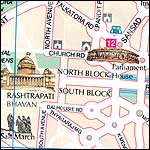 The Special Protection Group, in consultation with the Indian Air Force, intelligence and security agencies, has drawn up a detailed drill to take the prime minister to safety if his home is targeted aerially, sources in various agencies have told rediff.com
The Special Protection Group, in consultation with the Indian Air Force, intelligence and security agencies, has drawn up a detailed drill to take the prime minister to safety if his home is targeted aerially, sources in various agencies have told rediff.com
On February 9, a small plane violated the airspace over the prime minister's home. The scare was caused by Punjab Chief Minister Amarinder Singh's aircraft steering offcourse, just before it was to land at Safdarjung airport, which is hardly a kilometre from the prime minister's 7, Race Course home.
No aircraft is permitted to fly over 7, Racecourse Road. Last year, a Lufthansa cargo plane flew over the prime minister's home; its pilots have been banned permanently from flying to India.
The Directorate General of Civil Aviation has suspended the flying licenses of the two pilots who flew the Punjab chief minister's aircraft.
Various security agencies have now raised their old demand to shut down Safdarjung airport.
If a plane targeted the prime minister's home, what would happen?
Officials from India's intelligence and security agencies insist they have an emergency plan to counter such a contingency. If an aircraft were to "descend dangerously close" towards the pirme minister's home then an emergency evacuation plan for the premier, his family and senior officials would be implemented. All these people would be moved to a secure bunker within the 7, Race Course Road premises.
One senior intelligence official told this correspondent that the bunker is ready for use. However, others involved with the prime minister's security refused to acknowledge or discuss the bunker.
According to the intelligence official, the bunker is protected, self-contained and has enough food, water and other essential items to host the prime minister and his entourage for "a few days."
More importantly, it is protected from Nuclear-Chemical-Biological contamination.
The Special Protection Group also has an aerial evacuation plan to evacuate the prime minister via helicopter. A helipad has been built within the 7, Race Course premises to enable this, sources said.
If India's enemies mount a major attack, with Nuclear-Chemical-Biological elements, then the prime minister could be flown to the Indira Gandhi International airport and put on board a secure aircraft. India is trying to acquire an aircraft similar to the American Air Force One.
Sources said India has secure communication systems to keep the prime minister in touch with his Cabinet colleagues and military chiefs after he is airborne.
A senior official, who was earlier part of the prime minister's security detail, said the drills are "foolproof" and constantly updated.
There are some "defensive systems" in place within the 7, Race Course Road compound to take on aerial threats, he said, but added that these measures are not perfect.
"In case of a major aerial threat the IAF would be alerted," he said. The IAF would immediately press its surface-to-air missiles and fighters into action.
But, last Monday when the Punjab chief minister's aircraft flew over 7, Race Course Road, the IAF was not alerted, according to IAF sources.
"We first checked the identity of the aircraft with Safdarjung airport. Air control confirmed it was the plane carrying the Punjab chief minister," a security official said.
Once the IAF is alerted it would activate its air defence systems around the capital. Delhi has at least six dedicated air defence systems, equipped with surface to air missiles, anti-aircraft guns and radar.
If further support is needed for air defence, IAF fighters from Ambala would be summoned. "Ambala is the closest fighter base to Delhi," an IAF officer told rediff.com
The IAF's Hindon airbase on the outskirts of Delhi was abandoned a few years ago after several fighters crashed because of birdhits."We will re-activate Hindon soon," the IAF officer said.
"From Ambala a fighter would take about seven minutes to reach the VVIP area of New Delhi," the IAF officer said. "If it is an aircraft then our missiles and anti-aircraft guns can neutralise most of the threats."
What if the attack came via a missile?
The IAF official says India's ongoing acquisition of Israel's Phalcon airborne early warning systems and radar systems such as the Arrow and Greenpine would help India thwart an external missile threat.
But, as of now, the IAF official admits, "it is possible to hit the PM's home."
Says an intelligence official, "From the time the Punjab CM's plane flew over 7, Race Course Road to actually striking the premises it was a matter of few seconds. I don't know if we can neutralise such a threat without the PM's residence suffering collateral damage."
That is why Indian intelligence and security agencies have demanded that Safdarjung airport be permanently shut down. "It would allow us to expand the umbrella over the VVIP area and get more reaction time in case of an aerial threat," an intelligence official said.
If the plan is implemented, then Safdarjung airport, where Sanjay Gandhi died in June 1980, may be converted into a shopping mall as once suggested by the civil aviation ministry.







